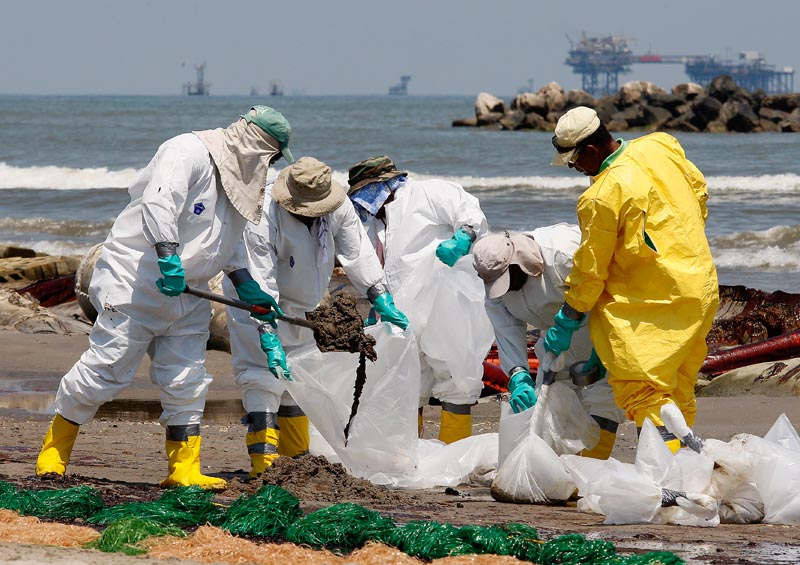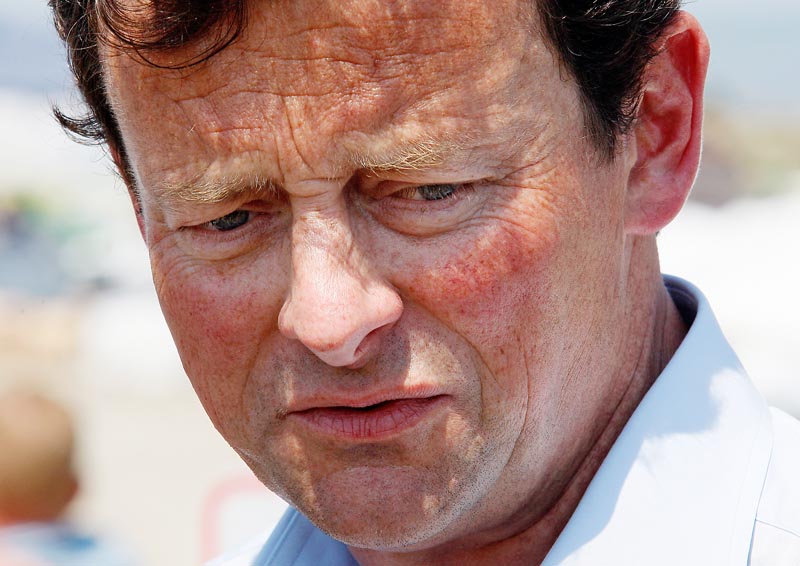COVINGTON, La. — The Obama administration’s point man on the oil spill rejected the notion of removing BP and taking over the crisis Monday, saying the government has neither the company’s expertise nor its deep-sea equipment.
“To push BP out of the way, it would raise the question, to replace them with what?” Coast Guard Commandant Adm. Thad Allen, who is heading the federal response to the spill, said at a White House briefing.
The White House is facing increasing questions about why the government can’t assert more control over the handling of the catastrophe, which unfolded after a BP offshore drilling rig blew up April 20.
All of BP’s attempts to stop the leak have failed, despite the oil giant’s use joystick-operated submarine robots that can operate at depths no human could withstand. Millions of gallons of brown crude are now coating birds and other wildlife and fouling the Louisiana marshes.
BP is pinning its hopes of stopping the gusher on yet another technique never tested 5,000 feet underwater: a “top kill,” in which heavy mud and cement would be shot into the blown-out well to plug it up.
The top kill could begin as early as Wednesday, with BP CEO Tony Hayward giving it a 60 to 70 percent chance of success.
Allen said federal law dictated that BP had to operate the cleanup, with the government overseeing its efforts.
“They’re exhausting every technical means possible to deal with that leak,” he said. “I am satisfied with the coordination that’s going on.”
Interior Secretary Ken Salazar suggested over the weekend that the government could intervene aggressively if BP wasn’t delivering. “If we find that they’re not doing what they’re supposed to be doing, we’ll push them out of the way appropriately,” he said.
But asked about that comment Monday, Allen said: “That’s more of a metaphor.”
Allen said BP and the government are working closely together, with the government holding veto power and adopting an “inquisitorial” stand toward the company’s ideas. The commandant also said the government has the authority to tell BP what to do, and such orders carry the force of law.
U.S. Senator Olympia J. Snowe (Rep.-Maine) is a senior member of the Senate Commerce, Science and Transportation Committee.
She participated in a hearing last week that examined the ongoing response efforts to the Gulf oil spill.
During the hearing, Snowe questioned officials from the Coast Guard and NOAA in addition to executives from the British Petroleum to assess government oversight of drilling operations and the effectiveness of cleanup efforts by the federal, state, and local government.
“I find it deplorable that neither BP or the federal government apparently gave any thought to how it would control a blowout of this magnitude prior to the tragic events of April 20,” Snowe said in a statement released by her office on Monday.
“It goes without saying that this was a failure of epic proportions. Furthermore, I find it extremely troubling that NOAA and the Coast Guard had no federal role in an integral part of developing from the ground up the assessments that govern offshore exploration.
It is a shocking oversight that our nation’s best ocean scientists would be relegated to the sidelines during development of such a stragegy,” Snowe said.
Snowe said she intends to make it a requirement for NOAA and the Coast Guard to be involved in issuance of drilling permits.
Homeland Security Secretary Janet Napolitano also took a more measured tone at a news conference Monday in Galliano, La., with Salazar and six U.S. senators who had flown over the coast to see the damage.
“We continue to hold BP responsible as the responsible party, but we are on them, watching them,” she said.
BP said it is doing all it can to stop the leak. Its chief operating officer, Doug Suttles, made the rounds of network morning news shows to say that the company understands people are frustrated.
“Clearly Secretary Salazar is telling us that we need to do this as expediently as we can,” Suttles said. “And of course we are.”
Hayward, BP’s chief executive, walked along oil-soaked Fourchon Beach and said he had underestimated the possible environmental effects.
“I’m as devastated as you are by what I’ve seen here today,” Hayward told reporters after he spoke with cleanup workers in white overalls and yellow boots, some shoveling oily sand into garbage cans.
“We are going to do everything in our power to prevent any more oil from coming ashore, and we will clean every last drop up and we will remediate all of the environmental damage.”
Mark Kellstrom, an analyst with Summit, N.J.-based Strategic Energy Research, said time might be running out for BP to continue calling the shots. “The rhetoric is growing up in Washington for the politicians to kick out BP and let the government take over,” Kellstrom said, though he added that it would be a mistake.
BP had hoped to try a top kill earlier but needed more time to get equipment into place and test it.
A top kill has worked on aboveground oil wells in Kuwait and Iraq but has never before been attempted so far underwater.
Suttles said the biggest technical challenge is that the fluid must be pumped in very quickly, and engineers need to make sure it goes into the well, not out through the leaking pipe, which could make the leak worse.
A containment device is on the seafloor, ready to be put in place if the top kill fails or makes the leak worse.
It is a smaller version of a 100-ton box that BP lowered several weeks ago in hopes of capturing much of the oil. But it got clogged with icy crystals, and BP was forced to abandon it.
Engineers are working on several other backup plans in case the top kill doesn’t work, including injecting assorted junk into the well to clog it up, and lowering a new blowout preventer on top of the one that failed.
Send questions/comments to the editors.




Success. Please wait for the page to reload. If the page does not reload within 5 seconds, please refresh the page.
Enter your email and password to access comments.
Hi, to comment on stories you must . This profile is in addition to your subscription and website login.
Already have a commenting profile? .
Invalid username/password.
Please check your email to confirm and complete your registration.
Only subscribers are eligible to post comments. Please subscribe or login first for digital access. Here’s why.
Use the form below to reset your password. When you've submitted your account email, we will send an email with a reset code.